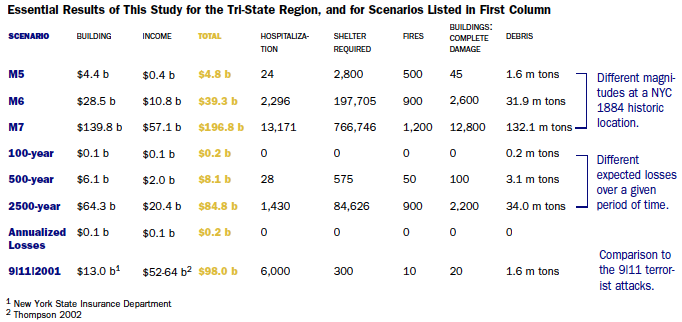What if the earthquake happened in Manhattan?


There would be catastrophic damage and substantial loss of life if an earthquake with the magnitude of today’s quake in Virginia would ever befall Manhattan.
Earlier today, a 5.9 magnitude earthquake struck Mineral, VA, and it rumblings were felt as far away as New Hampshire. My building in Manhattan shook for several seconds; people were flocking to social media to share what had just transpired.
While earthquakes aren’t a daily occurrence in the tri-state area, thousands of quakes have occurred without calamity over the past several centuries. However, a moderate M5 quake holds the potential for disaster.
“There are many faults have known to exist in New York City and mild earthquakes have been reported in the past. The highest magnitude was close to 5 in 1884 and did cause some damage (locations somewhere between Brooklyn and Sandy Hook; Lynn Sykes & Leonardo Seeber, Seismologist at Lamont Doherty). Such earthquakes (magnitude 5) have recurrence interval of 100 years or so (Lamont),” Nazrul Khandaker, associate professor and discipline coordinator of geology at the City University of New York wrote in an e-mail.
“Since then, rapid increase in population density, urbanization, and tremendous growth in overall infrastructure development in New York City have taken place. Based on our current infrastructure conditions, a hypothetical scenario of 5.9 magnitude earthquake taking place in New York City will be extremely attention-getting, as Armbruster (Lamont) mentioned in his seismological report,” Khandaker continued.
“Extremely attention-getting” is an understatement. Cornell University Earth and Atmospheric Sciences professor Matt Pritchard pointed me to a 2003 research report, “Earthquake Risks and Mitigation in the New York New Jersey, and Connecticut Region” that provides an assessment of what could happen.
Research for the report was conducted from 1999 to 2005 with contributions by the Federal government, New York, New Jersey, multiple universities, and the Multidisciplinary Center for Earthquake Engineering. Here are some of its key findings:
- A 5.2 magnitude quake has a 20-40% probability of occurrence over a 50-year period within the region.
- Thousands over 2.0 occurred over the past few centuries. In 2001 and 2002, 2.4 and 2.6 magnitude quakes happened, respectively.
- Magnitude 6 catastrophic events are possible. As noted by professor Khandaker, a 5.2M quake took place in 1884; another happened in 1734.
Here’s the impact that moderate to severe quakes would have on people, property, and infrastructure (I don't think that my renter's insurance has me covered):
- The entire region has a population of 18.5M, but greatest damage and concentration of deaths would in New York City.
- A moderate earthquake centered at 1884 historic site would cause 1,170 deaths at 2 PM in the afternoon. The fewest deaths would happen at 5 PM.
- 13,000 people would be injured in an M7 event – nearly double that of 9/11. That’s also 26% more people than there are available hospital beds.
- An M6 quake would cause 197,705 people to become homeless; a 2500-year event would require 84,626 people to seek short-term shelter in schools.
Buildings and Infrastructure would take a serious hit.
- The report concluded that even a moderate quake would have significant impact on economy and lives in tri-state region.
- The tri-state area has a US$1 trillion building replacement costs excluding building contents and non-building infrastructure. There is greater than $450B worth of real estate in Manhattan alone. Collapses and partial collapse and threats from fire were not included in the estimates.
- M5 quake losses are estimated at $4.8B.Losses for a 2500-yr event are comparable to 9/11 at $84.8B.A magnitude 7 quake at the 1884 historic site would cost over $198.6B. Half of the losses would happen in New York City.
- As many as 900 fires would break out simultaneously if a 2500-year event struck Manhattan.
- An M5 earthquake would generate over 1.6 million tons of debris - comparable to 9/11. Manhattan debris from an M5 quake would be 10,000 times its daily trash pickup. That volume leaps to 34M tons with a 2500-year event, or 21 times the debris from the ground zero site in lower Manhattan.
- Transportation and utility costs would exceed be $200M in event of a damaging earthquake. That does not factor in damage to essential facilities.
There are more than a few "essential facilities" within the tri-state region. There are approximately:
- 246 hospitals
- 123 emergency operation facilities
- 878 fire stations
- 1348 total dams (402 high hazard)
- 744 police stations
- 53,095 hazardous waste sites
- 2 nuclear power plants, including the controversial Indian Point reactor. 12 U.S. reactors declared "unusual events" after the quake, but the Nuclear Regulatory Commission has stated that reactors within the affected area were not damaged.
I don’t want to be accused of fear mongering at the expense of my fellow New Yorkers – we aren’t sinning any more than usual. CUNY’s professor Khandaker noted that occurrence of today’s earthquake in Virginia “was not out of the norm.”
“Several smaller magnitude earthquakes took place in close proximity to this epicentral area in the past and release of stress through ancient faults dating back to several hundred million years could be the probable reason for today's 5.9 Magnitude Earthquake (measurement confirmed by the United States Geological Survey). The localization of stress in this area is connected with the separation of eastern North America from Europe and Africa two hundred million years ago,” he said.
(Image Credit: "Earthquake Risks and Mitigation in the New York New Jersey, and Connecticut Region")
This post was originally published on Smartplanet.com